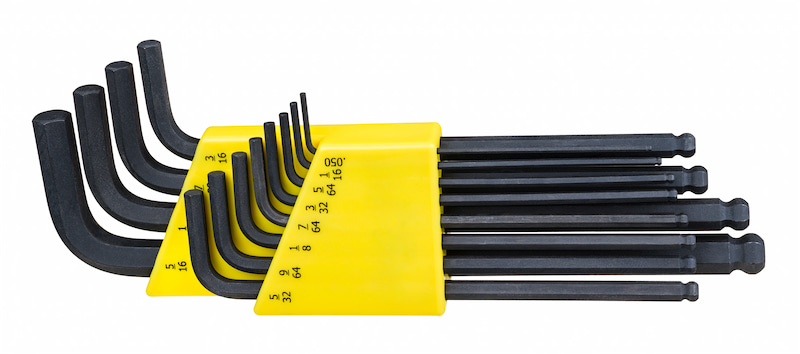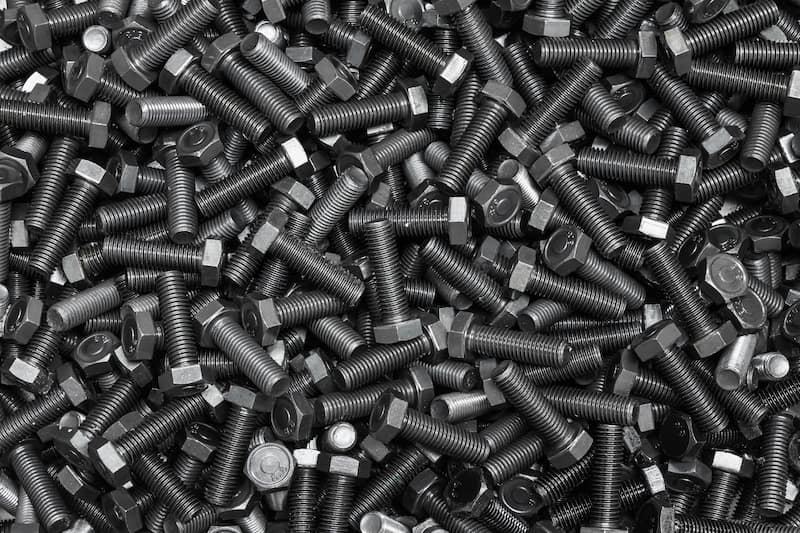Black Oxide coating is a type of chemical conversion coating mainly for ferrous metals but the process is adapted for stainless steel, copper, aluminium and zinc. Conversion coatings are different from conventional coatings, such as powder coating or electroplating, as they do not add or remove any metal from the substrate.
Instead, black oxide finish converts the surface layer of a part into one that boasts a great appearance, exhibits greater corrosion resistance and is non-reflective. The process is also often referred to as blackening, black passivating, oxidising and gun bluing.
What Is Black Oxide?
Generally, black oxide or black iron oxide refers to the oxide of iron known as magnetite (Fe3O4) that is formed when a ferrous metal is exposed to special oxidising chemicals. It is a type of conversion coating, thus the surface layer of a metal is formed into its oxide through conversion. The layer thickness on a finished part is between one and two micrometres.
The thin layer or coating along the part’s surface provides advantages such as greater corrosion protection, an attractive look and a smooth finish. As a result, many applications such as automotive parts use the black oxide coating process.
The blacking process works for some non-ferrous metals, such as zinc and copper, as well.
When Is Black Oxide Coating Used?
Black oxide coatings are used to increase corrosion and wear resistance while complying with high tolerance requirements. One of the advantages this process offers is the minimal buildup which means that the overall dimensions of the part only increase by a miniscule amount.
It is used on parts that require a certain degree of abrasion resistance as the black oxide does not wear away as easily as some other finishes. Black oxide parts are often used in the automotive and aerospace sectors in addition to being used in producing hand tools and other hardware. It is used to coat fasteners as black oxide finish improves their grip and corrosion protection while making them aesthetically pleasing.

How Does the Black Oxide Coating Process Work
The black oxide coating or blackening process is a chemical reaction in which the outer surface of a metal reacts to chemical solutions and therefore undergoes transformation.
The process is divided into three main types:
-
Hot black oxide process
-
Mid-temperature black oxide process
-
Cold black oxide process
Hot black oxide process
The hot black oxide coating process takes place at an elevated temperature of 141 °C (286 °F) and converts the surface of the ferrous material into magnetite (Fe3O4). Magnetite by nature is a black, opaque and magnetic material and thus, the surface turns black.
The entire process consists of seven steps::
-
Surface cleaning
-
Rinsing
-
Acid pickling
-
Rinsing
-
Black oxide chemical bath
-
Rinsing
-
Sealing
Surface cleaning
Cleaning the surface is the first step. A suitable alkaline detergent ensures the removal of contaminants such as grease, dirt, dust, rust, scales, fats, oils and even microorganisms. The alkaline solutions also do not stick to the surface and rinse off with ease.
Rinsing
A simple water bath is used to rinse the detergent. With the detergent, the emulsion of all the contaminants such as soil deposits also leaves the surface.
Acid pickling
Acid pickling is used to remove oxide films and rust stains. Technicians may skip this step if the part does not have the above-mentioned issues.
Rinsing
The part is rinsed again to remove the residues of acid from the previous step.
Black oxide chemical bath
The parts are then dipped into a hot bath that contains specific salts of sodium hydroxide (caustic soda), nitrates and nitrites. These blackening compounds convert the top layer of the part into magnetite Fe3O4.
Ion chloride solution (FeCl3) can also be used as the blackening compound. A 50% black oxide solution is generally sufficient.
The extent of blackening depends on the dipping duration. The blackening is quick at first but deeper shades require progressively longer times.
Rinsing
After achieving the desired shade, the parts are removed from the bath and rinsed once again to remove any compound residues.
Sealing
This is an additional step that ensures greater corrosion resistance. The part is exposed to a sealant such as oil that fills the pores in the black oxide surface and seals it by ‘sinking’ into it. The oil film also gives a glossy appearance to the part. A matte finish is achieved by replacing oil with clear wax. The sealant takes a while to dry completely.
Upon completion, the metal part will have an attractive black finish. Bearings are frequently blackened using this process.
The hot black oxide coating process is highly suitable for large batches. Automated part carriers can immerse parts for pre-determined durations in different baths.
It is the most popular type of blackening process. But it carries the risk of steam explosion as the process takes place above the boiling point of water.
- Personal account manager
- Quality assurance
- Payment terms for companies
- On-time delivery by Fractory
Mid-temperature black oxide process
The blackening process can also be carried out at temperatures below the boiling point of water. When it is carried out between 90 °C and 120 °C (194 °F – 248 °F), it is known as the mid-temperature black oxide coating process.
This process does not produce caustic fumes which are highly toxic to humans and, in extreme cases, can even lead to fatalities.
Cold black oxide process
The cold black oxide process takes place at room temperatures between 20 °C and 30 °C (68 °F – 86 °F). Unlike the previous two processes, this one does not include surface conversion to an oxide.
The cold process deposits copper selenide on the surface. This compound also has the characteristic black colour and produces a finish similar in appearance to the previous two processes.
However, the film is softer and can come off easily. The addition of a sealant is required to improve the corrosion resistance property just as the other two processes.
Other materials
The above processes work well with iron-based metals such as cast iron and carbon steel. However, some other materials can be blackened also. Let’s quickly dive into a few of those methods.
Copper
The black oxide process for copper converts the surface into cupric oxide and is called Ebonol C. A high-quality layer is created that can handle temperatures up to 200 °C (392 °F) with ease.
As with carbon steels, this layer requires sealing through oil, lacquer or wax for increased corrosion resistance.
Zinc
The blackening process for zinc goes under the trade name Ebonol Z. In this process, the zinc part is immersed in an alkaline solution at temperatures between 72 °C – 82 °C (160 °F – 180 °F).
The process imparts a dark black finish with mild corrosion resistance properties.
Stainless Steel
Black oxide is often used to eliminate the reflective nature of stainless steel in surgical instruments, for example. This reduces the mistakes that a surgeon could possibly make as the light does not reflect back to them during a procedure.
For stainless steel, the mid-temperature process works best. It takes place at 93 °C to 98 °C (200 – 210 °F) and provides a surface finish at par with hot black oxide. It works for 200, 300 and 400 series stainless steel.

Benefits
Black oxide coating is an intermediate process between protective coatings and plating processes. It provides many of the advantages of plating processes without being as expensive or difficult:
An attractive look
One of the most popular reasons why people opt for a black oxide finish is because of its aesthetic appearance. Blackening provides a clean and uniform surface without any spots. Either a glossy or matte appearance can be achieved by choosing the appropriate post-treatment sealant.
Affordable
Blackening is more affordable than electroplating and even paint. Cold black oxide process can even be carried out at home with regular equipment such as plastic containers.
Low dimensional changes
The part size grows due to oxide formation. However, this growth is minimal compared to other processes such as painting and electroplating.
The black oxide finish typically has a thickness of one to two micrometres which is almost negligible and does not affect functionality in most cases. Thus, the process is suitable for parts with tight tolerances.
Excellent surface finish
The black oxide process imparts a superior finish to the part. In addition to being smooth, the finish also takes on a protective role.
Minimises light reflection
Minimising light reflection can be a necessary property in many applications such as surgical tools and parts in radiation applications (UV and IR sensors and detectors).
By making the part less reflective and easy on the eyes, control and precision are improved in laparoscopic surgeries.
Improved corrosion resistance
The black oxide coating improves corrosion resistance to some extent provided a sealant is used to close the pores. However, the parts might still corrode in harsh environments.
In the case of stainless steel, the corrosion protection is enhanced further as the steel retains its corrosion-resistant property besides the protection offered by blackening.
Anti-galling properties
The black oxide coatings also impart anti-galling properties. This means that it prevents adhesive wear between parts when subjected to sliding contact.
This allows for a smoother break-in of mating parts. The black oxide coating is sacrificed but the surface becomes work-hardened, preventing further wear.
High lubricity
The black oxide layer has a low friction coefficient, especially if treated with wax/oil at the end.
Abrasion resistance
The black oxide layer also provides a certain degree of wear resistance. It does not peel off easily and is harder than the substrate in some applications. The enhanced hardness helps it deal more effectively with abrasive materials.
Limitations
The following limitations may prevent the use of black oxide coating for some purposes:
Mild corrosion resistance
The black oxide coating does not provide exceptional corrosion resistance. There are other cheaper alternatives if corrosion resistance is the main objective.
Layer erosion
Black oxide coatings have lower durability than other finishes and may get eroded, exposing the substrate to harsh conditions, especially hot environments. Moreover, the discolouration of the oil post-treatment to a dirty brown appearance can make the part look like it is rusting prematurely. The coating is also difficult to repair once damaged.
This is the reason why it’s not recommended to use black oxide coating for fasteners that will be securing an engine, for example.



